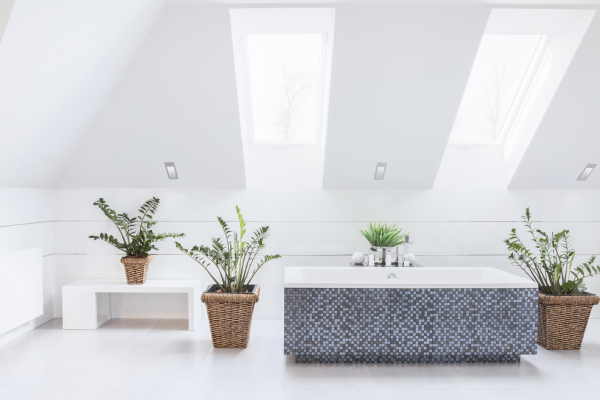
©KatarzynaBialasiewicz/Istock.com via AFP
If you’ve been on Pinterest recently then you’ve probably noticed that shower plants look set to be one of this year’s biggest wellness trends, helping to turn your bathroom into a more calming space and adding some mood-boosting greenery into your home.
But shower plants aren’t just a design feature, with even NASA looking into the ability of houseplants to naturally detoxify indoor air. A 1989 study carried out by the organization identified which plants were most effective at removing chemicals such as benzene, trichloroethylene, and formaldehyde from the air, helping to create a healthier space throughout your home.
Here we round up which plants are best for the more humid conditions of the bathroom, as well as some tips on how to care for them so even those of us without green fingers can enjoy their health benefits.
Broadleaf Lady Palm
The Broadleaf Lady Palm does well in humid conditions and likes low light, so avoid placing it next to a bathroom window. It is also one of the few houseplants to reduce levels of ammonia in the air, a chemical found in cleaning products, including those used in the bathroom.
English Ivy
Often seen growing outside a building, English Ivy also does well indoors. The plant not only helps filter out formaldehyde and benzene, but can also help reduce airborne fecal-matter particles, making it ideal for the bathroom area. It also likes the moist, humid conditions of the bathroom and bright light, however, avoid too much direct sunlight.
Chinese Evergreen
An easy option for those just getting started with house plants, the Chinese Evergreen can put up with most conditions although it will do particularly well in humid, low-lit bathrooms. It helps to filter out benzene, found in cleaning products and tobacco smoke, and formaldehyde, also found in tobacco smoke as well as home furnishings and cosmetic products.
Snake Plant
The Snake Plant, also known as Mother-in-Law’s tongue, is another easy-to-look after house plant. It does well in both bright and low-light areas and so will work in most bathrooms. It also likes most temperatures, including the humidity of a bathroom, and doesn’t need to be watered often. It’s also a great one for filtering chemicals, helping to remove benzene, formaldehyde, trichloroethylene, and xylene.
Boston Fern
Boston Ferns like indirect sunlight and a cool but very humid area, making it another suitable option for the bathroom. In fact, they like humidity so much that you might need to give this plant a little extra moisture even when it’s in the bathroom, misting it once or twice a week with water and checking soil daily to make sure it stays moist. Although it is slightly more high maintenance, once conditions are right it can live for years, grow to a good size, and brings the added health benefits of filtering out formaldehyde and xylene.
Bamboo Palm
Bamboo Palms help to remove benzene and trichloroethylene and are particularly effective at filtering formaldehyde, partly because they can grow as high as 4 to 12 feet tall, so make sure you put aside some space in the bathroom. They work well in low indoor light and moist conditions but make sure the soil doesn’t get too wet. MKH
RELATED STORIES:
Simple ways to keep your bathroom clean